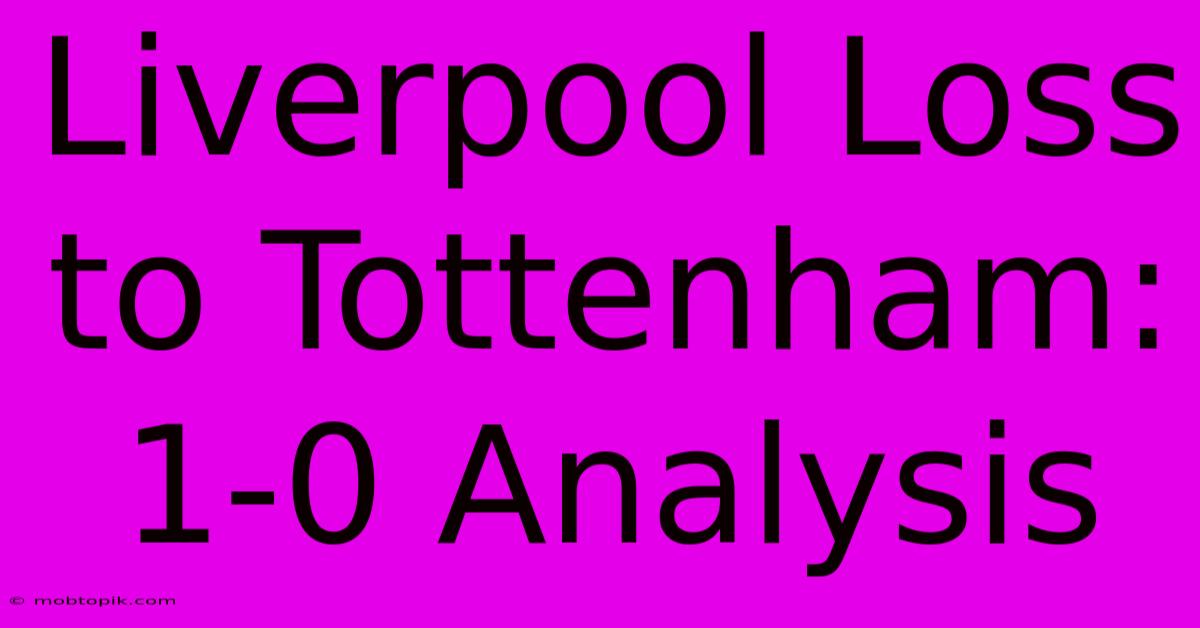Liverpool Loss To Tottenham: 1-0 Analysis

Discover more detailed and exciting information on our website. Click the link below to start your adventure: Visit Best Website mobtopik.com. Don't miss out!
Table of Contents
Liverpool Loss to Tottenham: A 1-0 Analysis – A Tactical Breakdown
Liverpool's 1-0 defeat at the hands of Tottenham Hotspur at Tottenham Hotspur Stadium was a sobering reminder of the challenges facing Jürgen Klopp's side this season. While the scoreline might suggest a closely fought contest, a deeper analysis reveals a performance riddled with tactical shortcomings and individual errors that ultimately cost the Reds. This article will delve into the key aspects of the game, examining Liverpool's weaknesses, Tottenham's strengths, and the overall tactical battle that unfolded.
Tottenham's Tactical Masterclass: Pressing and Exploiting Liverpool's Weaknesses
Tottenham, under the guidance of Ange Postecoglou, employed a high-pressing, possession-based system that effectively neutralized Liverpool's usual attacking fluidity. Their pressing strategy wasn't simply about winning the ball back; it was about forcing Liverpool into mistakes in dangerous areas.
The Effectiveness of the High Press:
Tottenham's pressing wasn't relentless chaos; it was intelligently coordinated. They forced Liverpool into quick, inaccurate passes, disrupting the rhythm of the midfield and preventing the usual incisive through balls that feed Liverpool's attackers. The compactness of their midfield and forward lines limited Liverpool's ability to bypass the press through dribbling, forcing them into predictable passing lanes.
Exploiting Liverpool's Defensive Vulnerability:
The absence of Virgil van Dijk was keenly felt. While Joel Matip and Ibrahima Konaté are capable defenders, the partnership lacked the same cohesion and communication that Van Dijk provides. Tottenham cleverly targeted the space behind Trent Alexander-Arnold, exploiting his tendency to push high up the pitch. This exposed the defensive line, creating several opportunities for Son Heung-min and Harry Kane.
Tottenham's Counter-Attacking Prowess:
Once possession was won, Tottenham transitioned swiftly into counter-attacks. Their pace on the wings, particularly from Son and Dejan Kulusevski, stretched Liverpool's defense, creating space for Kane to operate in central areas. This direct, counter-attacking style perfectly countered Liverpool's high defensive line.
Liverpool's Struggles: A Lack of Creativity and Defensive Fragility
Liverpool's performance highlighted several key areas needing improvement:
The Midfield Battle: A Lack of Control
The midfield battle was decisively won by Tottenham. Pierre-Emile Højbjerg and Yves Bissouma dominated the midfield, disrupting Liverpool's rhythm and winning back possession consistently. Liverpool's midfielders, including Dominik Szoboszlai and Alexis Mac Allister, struggled to exert their influence on the game, failing to create enough chances for the forwards. The lack of a dominant midfield presence hampered Liverpool's build-up play, resulting in numerous turnovers in dangerous areas.
Offensive Impotence: A Lack of Clear-Cut Chances
Despite their possession, Liverpool failed to create many clear-cut chances. Their usual incisive passing was lacking, and their forwards often found themselves isolated. The lack of creativity in the final third was a significant issue, with the front three struggling to combine effectively and find spaces behind the Tottenham defense. This highlights the need for better midfield-to-attack connections and a more varied attacking approach.
Defensive Errors Costly:
Beyond the absence of Van Dijk, Liverpool's defensive frailties were evident throughout the game. Individual errors, such as misplaced passes and poor positioning, contributed significantly to Tottenham's chances. The lack of communication between the defensive line and midfield also allowed Tottenham to exploit space behind the defense. This defensive vulnerability needs addressing urgently to prevent further setbacks.
The Winning Goal: A Tactical Masterstroke and a Defensive Lapse
Tottenham's winning goal was a perfect example of their tactical approach. A swift counter-attack, initiated from a Liverpool turnover, caught the Reds' defense off guard. Son's pace and skill created the space, and his cross found Kane perfectly positioned to deliver the decisive strike. The goal was a result of both Tottenham's tactical intelligence and a lapse in Liverpool's defensive concentration.
Looking Ahead: Areas for Improvement for Liverpool
The defeat to Tottenham exposes areas where Liverpool needs significant improvement:
-
Strengthening the Midfield: The lack of a dominant midfield presence is a critical issue. Investing in a more robust and creative midfield is essential to regain control of games.
-
Improving Defensive Cohesion: The absence of Van Dijk highlighted the importance of a strong and cohesive defensive partnership. Improved communication and tactical discipline are crucial.
-
Developing Offensive Fluidity: Liverpool needs to rediscover their offensive fluidity and creativity. This requires better interplay between midfield and attack and a more varied attacking approach.
Conclusion: A Harsh Lesson Learned
Liverpool's 1-0 loss to Tottenham wasn't just a defeat; it was a harsh lesson in the importance of tactical awareness, defensive solidity, and midfield dominance. While the absence of Van Dijk played a role, the team's overall performance highlighted several areas that require immediate attention. Unless these issues are addressed, Liverpool will continue to struggle against top opposition. The coming weeks will be crucial for Klopp and his team to regroup, analyze their weaknesses, and implement the necessary changes to get their season back on track. The defeat serves as a valuable learning experience, highlighting the need for strategic adjustments and squad improvements to compete at the highest level. The upcoming fixtures will be a true test of Liverpool's resilience and their ability to learn from this setback.

Thank you for visiting our website wich cover about Liverpool Loss To Tottenham: 1-0 Analysis. We hope the information provided has been useful to you. Feel free to contact us if you have any questions or need further assistance. See you next time and dont miss to bookmark.
Also read the following articles
| Article Title | Date |
|---|---|
| Tottenham Vs Liverpool Carabao Cup Match Result | Jan 09, 2025 |
| Gefahr In Hollywood Zentrum In Flammen | Jan 09, 2025 |
| Discord Fehler Behoben Die Ursache Analysiert | Jan 09, 2025 |
| Live Tottenham Hotspur Vs Liverpool Fc | Jan 09, 2025 |
| Spurs Edge Liverpool 1 0 Victory | Jan 09, 2025 |
